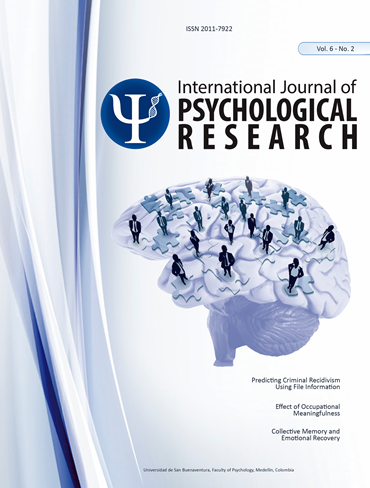Ver/Descargar
Cómo citar
Fries, D., Rossegger, A., Endrass, J., & Singh, J. P. (2013). La predicción de la reincidencia delictiva Usando información de archivos rutinariamente disponibles. International Journal of Psychological Research, 6(2), 8–14. https://doi.org/10.21500/20112084.671
Más formatos de cita
Términos de licencia
▼
The work that is sent to this journal must be original, not published or sent to be published elsewhere; and if it is accepted for publication, authors will agree to transfer copyright to International Journal of Psychological Research.
To give up copyright, the authors allow that, International Journal of Psychological Research, distribute the work more broadly, check for the reuse by others and take care of the necessary procedures for the registration and administration of copyright; at the same time, our editorial board represents the interests of the author and allows authors to re-use his work in various forms. In response to the above, authors transfer copyright to the journal, International Journal of Psychological Research. This transfer does not imply other rights which are not those of authorship (for example those that concern about patents). Likewise, preserves the authors rights to use the work integral or partially in lectures, books and courses, as well as make copies for educational purposes. Finally, the authors may use freely the tables and figures in its future work, wherever make explicit reference to the previous publication in International Journal of Psychological Research. The assignment of copyright includes both virtual rights and forms of the article to allow the editorial to disseminate the work in the manner which it deems appropriate.
The editorial board reserves the right of amendments deemed necessary in the application of the rules of publication.
To give up copyright, the authors allow that, International Journal of Psychological Research, distribute the work more broadly, check for the reuse by others and take care of the necessary procedures for the registration and administration of copyright; at the same time, our editorial board represents the interests of the author and allows authors to re-use his work in various forms. In response to the above, authors transfer copyright to the journal, International Journal of Psychological Research. This transfer does not imply other rights which are not those of authorship (for example those that concern about patents). Likewise, preserves the authors rights to use the work integral or partially in lectures, books and courses, as well as make copies for educational purposes. Finally, the authors may use freely the tables and figures in its future work, wherever make explicit reference to the previous publication in International Journal of Psychological Research. The assignment of copyright includes both virtual rights and forms of the article to allow the editorial to disseminate the work in the manner which it deems appropriate.
The editorial board reserves the right of amendments deemed necessary in the application of the rules of publication.
Resumen
Objetivo: El objetivo del presente estudio fue el de cross-validar la investigación de Buchanan y Leese (2006) en la predicción de la reincidencia criminal. Método. La muestra constó de delincuentes en el sistema de justicia penal del Cantón de Zúrich – Suiza, quienes fueron dados de alta a la comunidad. Los participantes fueron seguidos, y la evidencia de los cargos posteriores y condenas por reincidencia general y grave se investigó en períodos fijos de 2.5, 6.5 y 10.5 años. Se evaluó la validez predictiva de la historia criminal socio- demográficas e información de clase legal mediante regresión logística, así como el logaritmo de verosimilitud, la curva ROC, y análisis de contingencia. Resultados. Se encontró un modelo multivariable que incluye la edad y la información de antecedentes penales para producir los más altos índices de validez predictiva de reincidencia. Conclusión. Información habitualmente accesible en prácticas forenses puede ser capaz de guiar a los médicos respecto al nivel de riesgo de reincidencia de sus pacientes.
Palabras clave:
Referencias
Andrews, D. A., & Bonta, J. (2010). Rehabilitating criminal justice policy and practice. Psychology, Public Policy and Law, 16, 39-55.
Bonta, J., Law, M., & Hanson, K. (1998). The prediction of criminal and violent recidivism among mentally disordered offenders: A meta-analysis. Psychological Bulletin, 123, 123-142.
Buchanan, A., & Leese, M. (2006). Quantifying the contributions of three types of information to the prediction of criminal conviction using the receiver operating characteristic. The British Journal of Psychiatry, 188(5), 472-478.
Fazel, S., Singh, J. P., Doll, H., & Grann, M. (2012). The prediction of violence and antisocial behaviour: A systematic review and meta-analysis of the utility of risk assessment instruments in 73 samples involving 24,827 individuals. British Medical Journal, 345, e4692.
Hart, S. D., & Logan, C. (Eds.). (2011). Formulation of violence risk using evidence-based assessements: The structured professional judgement approach. Chichester, UK: John Wiley & Sons, Ltd.
Bonta, J., Law, M., & Hanson, K. (1998). The prediction of criminal and violent recidivism among mentally disordered offenders: A meta-analysis. Psychological Bulletin, 123, 123-142.
Buchanan, A., & Leese, M. (2006). Quantifying the contributions of three types of information to the prediction of criminal conviction using the receiver operating characteristic. The British Journal of Psychiatry, 188(5), 472-478.
Fazel, S., Singh, J. P., Doll, H., & Grann, M. (2012). The prediction of violence and antisocial behaviour: A systematic review and meta-analysis of the utility of risk assessment instruments in 73 samples involving 24,827 individuals. British Medical Journal, 345, e4692.
Hart, S. D., & Logan, C. (Eds.). (2011). Formulation of violence risk using evidence-based assessements: The structured professional judgement approach. Chichester, UK: John Wiley & Sons, Ltd.
Descargas
Los datos de descargas todavía no están disponibles.

































